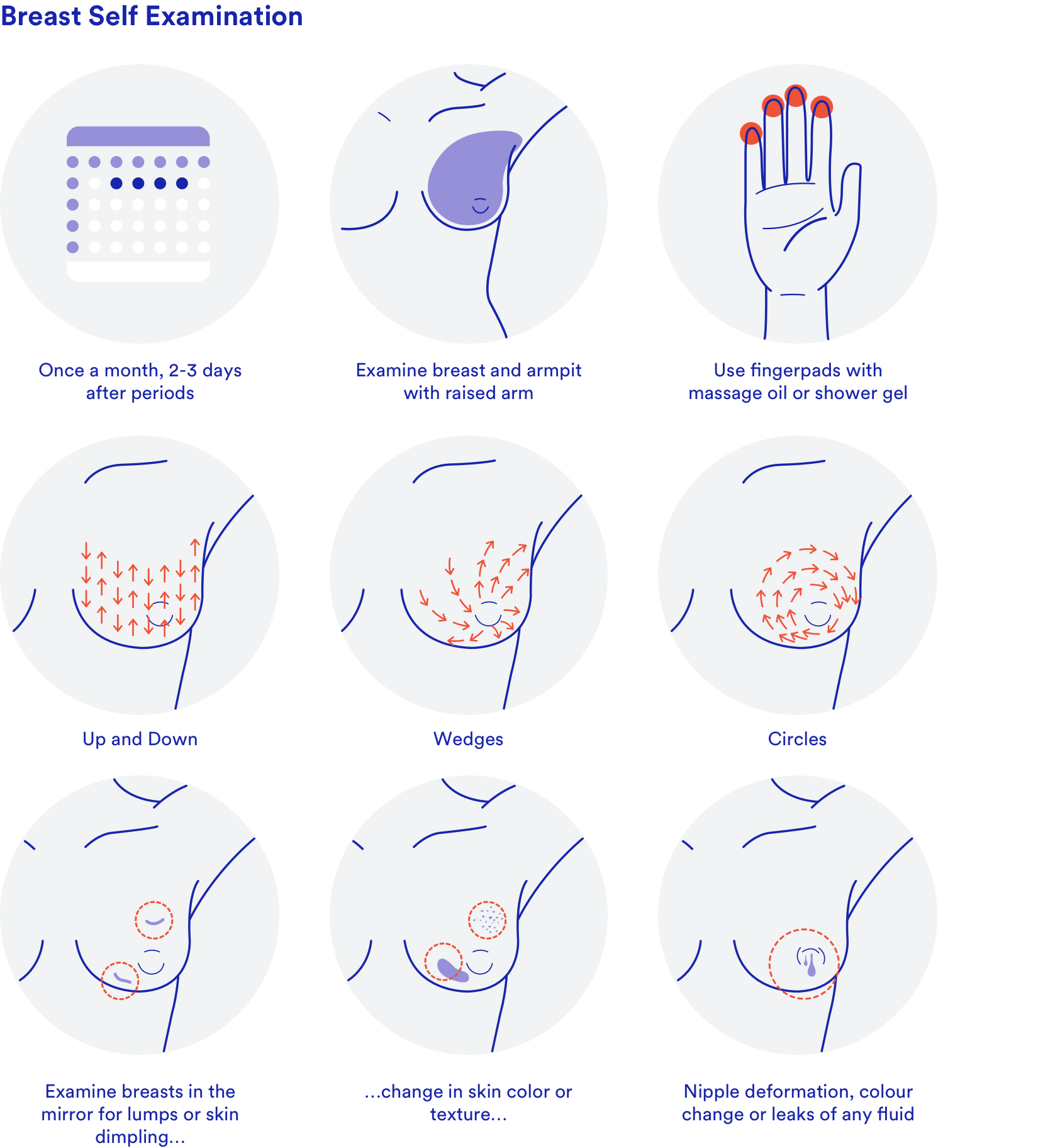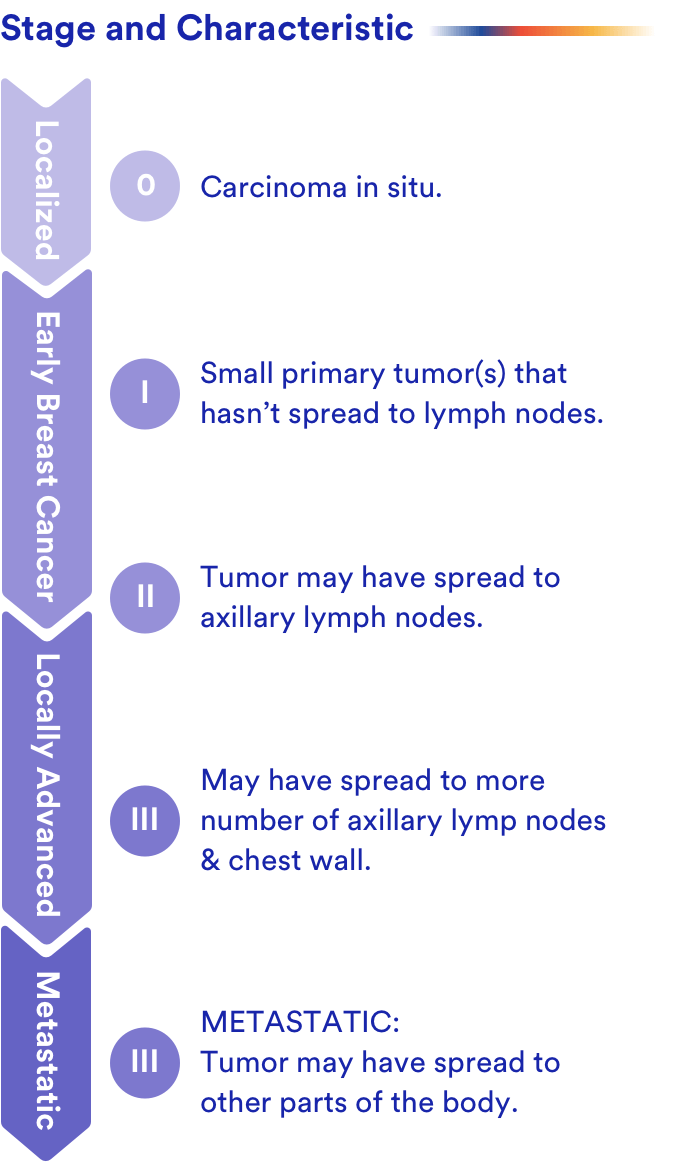
Metastatic Breast Cancer
How is breast cancer diagnosed and detected?
Prevention, regular screening and early detection are the watchwords for breast cancer.
It is possible to detect breast cancer early, if one performs routine screening and examination. If detected & treated early, the chances of survival are higher. Below are recommended methods of breast cancer screening:
I. Breast self-examination (BSE)
BSE can be regularly performed in addition to mammography screening or a CBE. One can do this at the end of regular monthly periods or for those after menopause, on the same date and time every month (Figure 2). In BSE, one does a monthly self-check for any lumps or other abnormal changes in and around the breast (including armpits). BSE is not exactly a cancer screening tool, but at times, it can help locate a lump that might be otherwise too small, hence missed during routine tests. Given this, every lump thus found need not be cancerous.
II. Mammography Screening
Mammogram is an X-ray photograph of the breast. Mammography helps in early diagnosis, making it easier to treat, evaluate and follow progress of the disease. For women above the age of 40, an annual mammogram screening may be recommended. According to the American Cancer Society (ACS), women with BRCA gene mutations, prior radiation therapy to the chest, or a very strong family history for breast cancer should consider mammography and MRI each year, sometimes 6 months apart between the tests.
III. Clinical breast examination (CBE)
CBE refers to a careful examination of breasts by a trained and experienced health care professional. It is recommended that women below 40 years of age, have a CBE done every 3 years and those above 40 have it done yearly.
If an abnormality is suspected in the shape and feel of the breast, one must consult doctor immediately. An abnormality in the mammogram will also be a warning sign to get expert help.
Diagnosis is done with the help of follow-up tests. There can be a follow-up mammogram (diagnostic), breast ultrasound or a breast MRI. If there is a likelihood of cancer, the doctor may recommend a biopsy. Also, it is always good to get a second opinion for a more accurate diagnosis. Breast cancer survival rates are higher if detected early, which is possible with routine screening and examination.
IV. Biopsy
During biopsy, a portion of the suspected tissue area is removed with a needle (needle biopsy) or a cut (surgical biopsy). This tissue is studied under the microscope by a pathologist.
V. Diagnostic Mammogram
Mammography is known to be the most effective screening and diagnostic tool for breast cancer. During mammography, X-rays are used to create an image (‘mammogram’) of the breast. A radiologist reads these images to study the signs and extent of cancer.
VI. Breast Magnetic Resonance Imaging (MRI)
MRI, that uses magnetic fields to take multiple images of the breast tissue for detailed analysis is helpful in screening for those who are at high risk for breast cancer.
VII. Breast Ultrasound
Breast ultrasound is a non-invasive test where sound waves are used to create images of the breast. These images are hence called ‘sonograms’. While performing needle biopsy, breast ultrasound may also help in guiding the procedure.
How is breast cancer staged?
A combination of tests, as directed by your doctor, will help in staging of breast cancer.
Why is staging important? Knowing the stage of the cancer helps assess the extent to which it might have grown and spread. It also helps the doctor to determine the best treatment regimen.
Roughly, there are 5 stages to breast cancer, based on the pathology of three main determinants: the Tumour (T), the Node (N), and the extent of Metastasis (M). This method of staging breast cancer is called the TNM staging method (Figure 3).
Abbreviations
ACS: American Cancer Society BSE: Breast self-examination CBE: Clinical Breast examination IV: Intravenous mBC: Metastatic breast cancer MRI scan: Magnetic resonance imaging scan NCCN: National Comprehensive Cancer Network VEGF: Vascular Endothelial Growth Factor
References
- Breast Cancer Journey, Third Edition, American Cancer Society, 2013
- Bray, F., Ferlay, J., Soerjomataram, I., Siegel, R. L., Torre, L. A., & Jemal, A. (2018). Global cancer statistics 2018: GLOBOCAN estimates of incidence and mortality worldwide for 36 cancers in 185 countries. CA: A Cancer Journal for Clinicians, 68(6), 394-424. doi:10.3322/caac.21492
- Redig, A. J., & McAllister, S. S. (2013). Breast cancer as a systemic disease: a view of metastasis. Journal of internal medicine, 274(2), 113–126. doi:10.1111/joim.12084
- Berkey CS, Tamimi RM, Rosner B, Frazier AL, Colditz GA. Young Women with Family History of Breast Cancer and their Risk Factors for Benign Breast Disease. Cancer. 2012;118(11):2796-2803. doi:10.1002/cncr.26519.
- Rosner B, Colditz GA and Willett WC. Reproductive risk factors in a prospective study of breast cancer: the Nurses’ Health Study. Am J Epidemiol. 139: 819-835, 199
- Transient Increase in the Risk of Breast Cancer after Giving Birth, Mats Lambe, Chung-cheng Hsieh, Dimitrios Trichopoulos, Anders Ekbom, Maria Pavia, and Hans-Olov Adami, N Engl J Med 1994; 331:5-9July 7, 1994DOI: 10.1056/NEJM199407073310102
- Kushi, L. H., Doyle, C., McCullough, M., Rock, C. L., Demark-Wahnefried, W., Bandera, E. V., Gapstur, S., Patel, A. V., Andrews, K., Gansler, T. and The American Cancer Society 2010 Nutrition and Physical Activity Guidelines Advisory Committee (2012), American Cancer Society guidelines on nutrition and physical activity for cancer prevention. CA: A Cancer Journal for Clinicians, 62: 30–67. doi:10.3322/caac.20140
- Wu Y, Zhang D, Kang S. Physical activity and risk of breast cancer: a meta-analysis of prospective studies. Breast Cancer Res Treat. 137(3):869-82, 2013
- Screening and Early Detection, Susan Komen Foundation, Available at https://ww5.komen.org/breastcancer/earlydetectionampscreening.html, Accessed on 26.03.2019
- Brierley, J.D.; Gospodarowicz, M.K.; Wittekind, Ch., eds. (2017). TNM classification of malignant tumours (8th ed.). Chichester, West Sussex, UK: Wiley-Blackwell. ISBN 978-1-4443-3241-4.
- Treating breast cancer, Susan Komen Foundation, Available at: https://ww5.komen.org/BreastCancer/TreatmentIntroduction.html, Accessed on 26.03.2019





